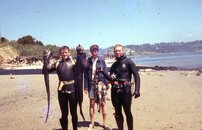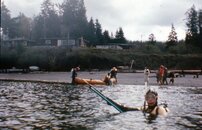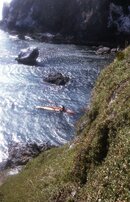JOHN
Ron's twin tube snorkel is very old - ancient technology way back to the very beginnings of recreational diving and spearfishing all the way back to the San Diego Bottom Scratchers .
I do applaud his ingenuity and techniques of adapting and certainly construction with modern materials
sdm
Sam,
As one of the original San Diego Bottom Scratchers, it's really great to see you are following this thread. Thank you for your input here. I was still a kid cutting off the ping pong ball of a plastic "C" snorkel to get a good snorkel for snorkeling in a cool
YMCA Camp Silver Creek reservoir (see the black & white photo at this link) when you were doing this with the Bottom Scratchers in the early 1950s.
In those days, we who when into scuba diving had been snorkeling as kids for years before getting into scuba diving. I bought my first scuba unit (a Healthways SCUBA double hose regulator with a 38 cubic foot tank) from money I earned picking strawberries and beans in the fields of the Willamette Valley near Salem, Oregon. I was a YMCA and North Salem High School Swim Team member, and had gone through YMCA Lifesaving classes while snorkeling. I also was scuba diving in 1959, three years before getting certified by LA County, and a year before I got my first wet suit (a White Stag wet suit). Because of this, weighting was as if I were in my swim suit, and the need for buoyancy compensation was unknown until we went into deeper saltwater in Hood Canal, Washington.
Before scuba, we free dived for spearfishing, and continued that on scuba. The photos below show free diving, using paddle boards, and spearfishing as a teenager in Hood Canal, Washington. Note, in an emergency, we simply dumped our weight belt. Watermanship was a premium for diving, and we were very, very comfortable in the water. During our LA County scuba course, our last pool session was when Roy France, our LA County Instructor, dropped a weighted gill net over us as a buddy pair, and we had to remove ourselves from under the net, untangling it from each other's valves on the scuba unit, and helping each other out from under the net.
SeaRat








